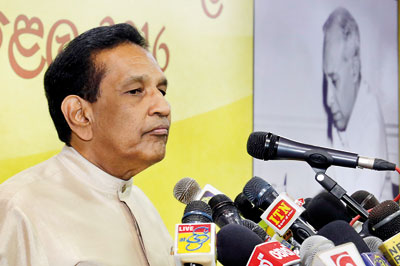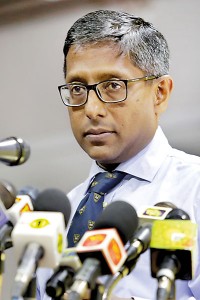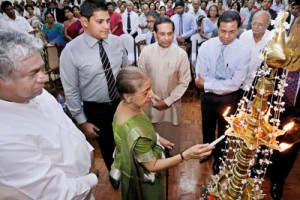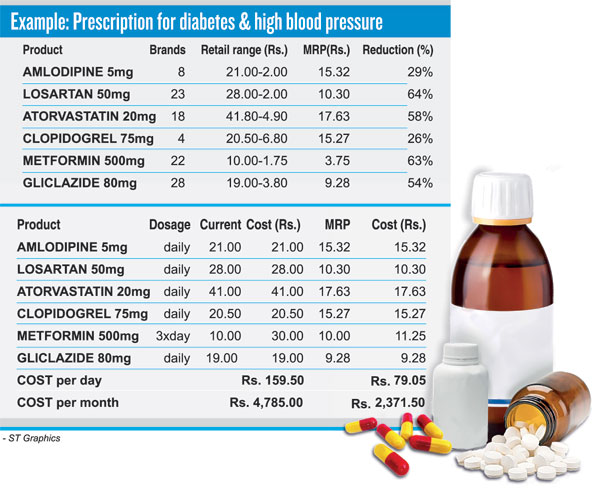News
Vital drug prices to come down at last

Health Minister Dr. Rajitha Senaratne announcing the new drug pricing formula
Prices of nearly 50 ‘essential’ or ‘life-saving’ drugs are to be slashed shortly, under a proposed formula to be finalised very soon, bringing the curtain down, to some extent, on a decades-long debate on costly medicines.
In some cases, the proposed reduction is over 50%, with the price of Atorvastatin (a drug for high cholesterol) being cut by 58%, from Rs. 41 to about Rs. 18 per tablet and metformin (a drug for diabetes) by 63%, from Rs. 10 to just over Rs. 3 per tablet. Clopidogrel (a drug to prevent blood clots) price, meanwhile, has been brought down by 26% from Rs. 20.50 to Rs. 15.27 per tablet.
The price-slashed 47 essential medicines include those used in the treatment of major non-communicable diseases (NCDs) such as diabetes, ischaemic heart disease, high blood pressure, high cholesterol and bronchial asthma; many widely-used antibiotics; and others used for gastrointestinal ailments, hormone disorders and common psychiatric problems.
The announcement about the lowering of drug prices was aptly made by Health Minister Dr. Rajitha Senaratne during the Prof. Senaka Bibile Commemoration Festival 2016 organised by the Sri Lanka State Pharmaceuticals Corporation (SPC) on Friday at the Sri Lanka Foundation Institute in Colombo.
Stressing the need to provide quality (safe and effective) medicines at an affordable price to the public at large, which was the vision of Prof. Bibile who was hailed worldwide, Minister Senaratne harked back to the past, referring to a lecture-session in Peradeniya that he was part of as a youth, where Prof. Bibile had compared the price of two cents of the generic aspirin at that time to that of the 12-cent brand and vowed to get rid of the disparity.

National Medicines Regulatory Authority Chairman Prof. Asita de Silva explaining the new drug pricing formula
The new pricing mechanism will come under a Maximum Retail Price (MRP) formula till a long-term solution is found, according to National Medicines Regulatory Authority (NMRA) Chairman Prof. Asita de Silva, with this formula being expanded to cover ‘chunks’ of drugs based on the essential medicines principles.
“The price reductions on the 47 essential drugs, based on the MRP formula, being successfully followed by India since 2013, are expected to have a very positive impact on the cost of these essential medicines,” he said, explaining that the “finishing touches” are now being done and the Gazette notification on the new and lower prices which would bring immediate relief to the patients will come shortly thereafter.
It is under the guidance of Minister Senaratne — who has been pushing for a cut in drug prices which is a huge burden on patients who include thousands of retirees who have served the country – that he, the NMRA’s Pricing Committee Chairman Dr. Palitha Abeykoon, Health Ministry officials, members of the Sri Lanka Chamber of Pharmaceutical Industry and small-scale importers are ‘touching up’ the MRP formula, said Prof. de Silva who took over as NMRA Head around the end of June.
While citing an example (see graphic) of how the price-cuts will impact on the life of a patient, he said that when the MRP formula is implemented, the prices of these 47 essential medicines, in whatever form they are in, be it tablet, injectable or syrup, will be reduced by around 30-50% on average. There will be a reduction of up to 40-50% on average on a prescription of four to five widely-used medicines treating a patient suffering from chronic diseases like diabetes and high blood pressure.
When contacted by the Sunday Times after the Bibile commemoration, Prof. de Silva described how the MRP formula would work. Having looked closely at the ‘Price-fixing Model’ introduced by India in 2013, firstly for 30 essential drugs and now covering more than 450 formulations, he said that Pricing Committee Chairman Dr. Abeykoon, along with inputs from himself studied the market retail prices of both brands and generics of each type of drug with a significant market share. Thereafter, they worked out a median price for a particular formulation and used that as the ‘maximum price’ that that particular drug can be sold at.
Pointing out that the price range of a specific drug is very wide, he explains that if the price of a drug that falls into this category is higher than the median price, it would have to be brought down to the median price. If, however, it is lower, then the price cannot be raised up to the median price. “The median price would be the maximum price for those formulations of a specific drug which are of a higher price than that. But what has been of a lower price cannot be upped. It is only those at the higher end which will come down.”
The price of medicinal drugs is unacceptably high in Sri Lanka and patients, especially those taking treatment for chronic diseases find it extremely difficult to purchase medicines as prescribed by their doctors. This also leads to non-compliance in the drug regimen prescribed, causing more complications, he said.
The NMRA established in 2015 was tasked to provide safe and effective medicines at affordable prices to patients. Recent suggestions which had been discussed, it is learnt, included a price structure based on the Cost, Insurance & Freight (CIF) value plus a mark-up to a maximum of 85%. However, the Minister, he and Dr. Abeykoon were not fully in favour of this formula, with a major reason being the inability to verify the CIF value provided by importers. Thereafter, Prof. de Silva with “valuable” inputs from the Consumer Affairs Authority (CAA) and Dr. Abeykoon, and after studying an expert report submitted to the World Health Organization (WHO), devised a price structure based on the MRP model.
Extensive discussions were held with the stakeholders, while the CAA provided the entire database of medicines to the NMRA Chairman. Then Prof. de Silva and Dr. Abeykoon also looked at the IMS (Islandwide Marketing Services Pvt. Ltd.) information which contained comprehensive pricing data of the pharmaceutical industry in Sri Lanka, including what the market share of each and every drug was, it is learnt. What became clear was that the CIF value of a particular drug was not verifiable and the CIF quoted by the importer had to be accepted.

Mrs. Leela Bibile, wife of Prof. Senaka Bibile, lighting the traditional oil lamp to launch the proceedings of the Commemoration Festival on Friday. Pix by M. A. Pushpa Kumara
The report by the WHO expert, meanwhile, had shed light on the water-tight system in place in Saudi Arabia which was pricing its drugs on the CIF value. Under that system, not only was the drug importer mandatorily required to furnish a CIF certificate from the country of origin of the drug, but the importer also had to get it verified and certified by the Saudi Arabian embassy based in that country.
It was then that Prof. de Silva along with Dr. Abeykoon decided, in consensus with all stakeholders, to introduce the MRP to bring down drug prices as an immediate measure to ease the burdens on patients until a long-term price formula is implemented. At the Bibile commemoration, Minister Senaratne commended the NMRA chief for devising the formula within two months.
Meanwhile, when asked what his “priorities” are after taking over the NMRA about two months ago, Prof. de Silva said they are to focus on the pricing of medicines and bring them down; improve infrastructure where the staff can work with efficiency and dignity under a system that is not individual-driven but process-driven; and automate that process by computerising the system.
Prof. de Silva added that with regard to automating the process, he has already written to the Information and Communication Technology Agency (ICTA) which has agreed in principle to undertake this job and a meeting is scheduled for tomorrow to discuss the type of software and hardware that would be needed to increase efficiency and transparency.


